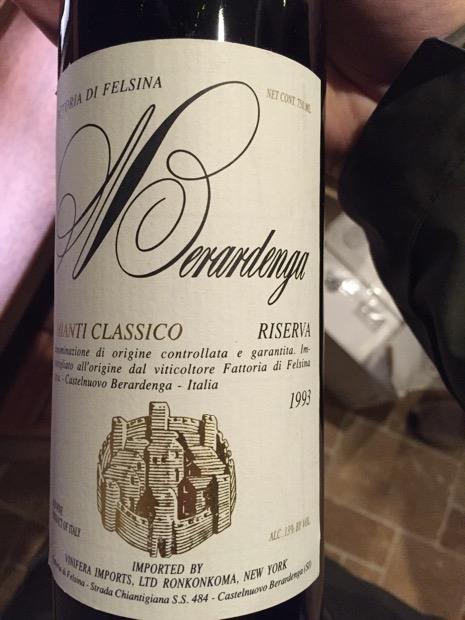
External search
Google (images)
Wine Advocate
Wine Spectator
Burghound
Wine-Searcher
Vintages
2020
2019
2018
2017
2016
2015
2014
2013
2012
2011
2010
2009
2008
2007
2006
2005
2004
2003
2002
2001
Show more
From this producer
Show all wines
All tasting notes
|
| Drinking Windows and Values |
| Community Tasting History |
| Community Tasting Notes (average 89.5 pts. and median of 89 pts. in 2 notes) - hiding notes with no text | | | Tasted by Duncan on 9/1/2015 & rated 89 points: A healthy-looking, velvety purple. A nose of decaying woodlands...a whiff of liquorice...smoky treacle, or maybe molasses. On the palate, good acidity, quite a lot of tannins - fine to medium - and good length. All in all, an interesting experience, but no longer a great wine. Or rather, no longer a great bottle - it's just too old, really no fruit at all left. I'm grateful to have tried it, but would prefer a five or ten year old bottle, rather than a 22 year old one. 13%, cork. (1109 views) | | | Tasted by Duncan on 12/31/2013 & rated 90 points: Deep purple; a narrow clear rim, but no bricking. On the nose, dried fruit emerges from an underbrush of decay. A reasonably long, dry finish, with significant tannic structure. By itself quite challenging, but with cheese excellent. 13%. (1437 views) |
| Fattoria di Fèlsina Berardenga Producer website
U.S. Importer (Addt'l Info)
Producer Location (Google Maps)
This historic estate, which dates to the Middle Ages, was purchased by current owner Giuseppe Mazzocolin's father-in-law, Domenico Poggiali, in 1966. Winemaker Franco Bernabei draws on vines more than 50 years old from three vineyards-Fontalloro in Chianti Classico and the Casalino and Arcidossino vineyards in Chianti Colle Senesi-for this red. Because it straddles two DOCG zones, the wine is classified as Indicazione Geo-grafica Tipica (IGT). After fermentation, it was aged in barriques for 20 months. SangioveseSANGIOVESE: (Pronounced "sahn-joh-vhe-se").
Sangiovese - Italy's claim to fame, the pride of Tuscany. Traditionally made, the wines are full of cherry fruit, earth, and cedar. It produces Chianti (Classico), Rosso di Montalcino, Brunello di Montalcino, Rosso di Montepulciano, Montefalco Rosso, and many others. Sangiovese is also the backbone in many of the acclaimed, modern-styled "Super-Tuscans", where it is blended with Bordeaux varietals (Cabernet Sauvignon, Merlot, and Cabernet Franc) and typically aged in French oak barrels, resulting a wine primed for the international market in the style of a typical California cabernet: oaky, high-alcohol, and a ripe, jammy, fruit-forward profile.[16]
Semi-classic grape grown in the Tuscany region of Italy. Used to produce the Chianti and other Tuscan red wines. Has many clonal versions, two of which seem to predominate. The Sangiovese Grosso clone Brunello variety is used for the dark red, traditionally powerful and slow-maturing "Brunello di Montalcino" wine. The other is the Sangiovese Piccolo, also known under the historical synonym name Sangioveto, used for standard Chianti Classico DOC wines. Old vine derived wine is often used in the better versions, needing several years ageing to reach peak. A third clone, Morellino, is used in a popular wine blend with the same name found in the southern part of the province. Recent efforts in California with clones of this variety are very promising, producing medium-bodied reds with rich cherry or plumlike flavors and aromas. Among the available clonal versions are R6 and R7, derived from the Montalcino region of Italy, having average productivity/ripening and producing small berries on medium size clusters. R10 and R24 are well-recommended. R23, listed as deriving from the Emilia-Romagna region, has good vigor with medium-small clusters with earlier ripening. R102 derives from the Montepulciano region and reported to have average vigor with moderate productivity that results in higher sugar levels and good acidity from medium-small berries on medium-small clusters. Has synonym name of Nielluccio where grown in Corsica.Italy Italian Wines (ItalianMade.com, The Italian Trade Commission) | Italian Wine Guide on the WineDoctorTuscany Tuscany (ItalianMade.com) | TuscanytChianti Consorzio Vino Chianti | Chianti (wikipedia) |
|




